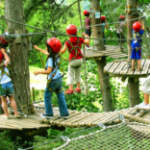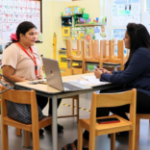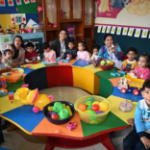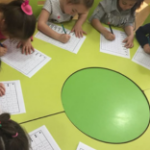
The world is transforming at an unprecedented pace because of the advances in science, technology, engineering, and mathematics. These are not just the fields shaping industries, but they are also defining the way education is pursued. While it has historically been associated with older students, there is an emerging powerful trend of introducing STEM education from early childhood. The move acknowledges that problem-solving, creativity, and critical thinking skills should be encouraged from a very young age.
STEM education in early childhood transcends preparing children for future careers. It is about developing curious minds, encouraging exploration and discovery, and building a solid basis for lifelong learning. Find out why STEM is significant in early education, its application, and the associated benefits for young learners:
Why Introduce STEM Early?
Children are naturally inquisitive and imaginative. The desire to explore the world is at its peak during early childhood, which makes it a perfect time for introducing STEM concepts. This phase of rapid development is just right to shape skills and habits that will benefit them throughout their lives.
Some reasons why STEM is now a growing focus in early childhood education:
1. Develops Problem-Solving Skills: STEM activities encourage children to think critically and find solutions to challenges.
2. Fosters Creativity: Projects like building towers or creating simple machines inspire innovative thinking.
3. Build Confidence: Completing STEM challenges, no matter how simple, gives children a sense of accomplishment.
4. Encourages Teamwork: Many STEM activities are collaborative, helping children learn to share ideas and work together.
5. Prepares for the Future: As technology becomes an important part of daily life, exposure to STEM at an early age helps children adapt and thrive in the tech world.
STEM in Early Learning: What It Looks Like
Introducing STEM in early education doesn’t require fancy tools or complicated concepts. It’s about making learning fun, hands-on, and exploratory. Here’s how each component of STEM can be integrated into activities for young children:
Science:
Children learn science in the most simple form through activities like observing growth in plants, mixing colors, and the properties of water. All these teach them a lot about the natural world and ignite their passion to discover more.
Technology:
For a young learner, technology could mean age-related tools like coding toys or an interactive app, or how the flashlight works. These introduce a learner to the basic aspects of technology, all of which stay fun and engaging.
Engineering
Building bridges with blocks, designing ramps for toy cars, or creating structures with everyday items helps the child understand the concepts of engineering like balance and stability.
Mathematics:
Counting, sorting objects by shape or size, and recognizing patterns are essential math skills that can be developed. Even the cooking activity can introduce concepts like measurement and proportions.
Benefits of STEM in Early Childhood Education
The introduction of STEM in early education provides numerous advantages that go beyond academics. Here’s how STEM helps young learners:
Encourages Curiosity: STEM activities feed children’s natural curiosity and encourage them to ask “why” and “how.”
Enhances Cognitive Development: STEM challenges stimulate brain development and improve memory, focus, and reasoning.
Promotes Resilience: STEM often involves trial and error, teaching children to embrace failure as a step toward success.
Supports Social Skills: Group STEM activities teach communication, cooperation, and the value of sharing ideas.
Sparks Lifelong Learning: By making learning enjoyable, STEM fosters a love for discovery that continues into adulthood.
Simple STEM Activities for Young Students
Parents and educators can easily incorporate STEM activities into daily routines. Here are a few simple yet effective ideas:
The Sink or Float Experiment:
Fill a bowl with water, and gather spoons, a toy, or sponge for the demonstration. Ask them to guess if it is going to float or sink, and test it out.
Lego or Block Challenges:
Building the tallest tower or the most efficient bridge to support a toy car are examples of an introduction to engineering and problem-solving activities.
Nature Walks:
Take children on a walk to observe plants, insects, or rocks. Ask them what they see and encourage questions.
Color Mixing:
Use food coloring or paint to demonstrate how primary colors mix to make new colors. This is basic science and encourages creativity.
Coding for Kids:
Use simple coding toys or apps to introduce the basic concepts of programming in a fun and interactive way.
Overcoming Challenges in STEM Education
While the benefits of STEM in early education are evident, its implementation often comes across as a challenge in many schools, given a lack of resources or trained educators. However, several tools and programs have become available to bridge this gap. Schools and parents can collaborate to create a supportive environment where STEM activities become a natural part of everyday learning.
Building the Future with STEM
Early childhood STEM education is far more than academics; it’s a mindset of teaching a child to think, solve, and find creative solutions. It creates a future of hope.
At Tiny Tots India, we have a strong belief in early learning that will help kids grow into confident, inquisitive, and capable individuals. We provide early learning tools that prepare our children for the fast-paced world they will face through early concepts of STEM.
Summary:
STEM education is increasingly being introduced in early childhood to foster problem-solving, creativity, and critical thinking from a young age. At AR Tiny Tots International School, Pimpri-Chinchwad, Pune, children explore science, technology, engineering, and mathematics through fun, hands-on activities such as nature walks, block-building, and color mixing. These activities spark curiosity, build cognitive and social skills, and prepare children for the future. By integrating STEM into early education, Tiny Tots aims to nurture confident, inquisitive, and capable individuals ready to thrive in a rapidly changing world. Big ideas truly start small, and early STEM education lays the groundwork for tomorrow’s innovators.
Let’s start inspiring the next generation of innovators—because big ideas do start small!




